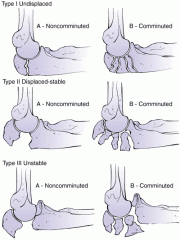![]()
![]()
![]()
Use LEFT and RIGHT arrow keys to navigate between flashcards;
Use UP and DOWN arrow keys to flip the card;
H to show hint;
A reads text to speech;
11 Cards in this Set
- Front
- Back
|
Describe a the "direct" mechanism of injury in an olecranon fx. |
A fall on the point of the elbow or direct trauma to the olecranon typically results in a comminuted fx (less common) |
|
|
Describe the indirect MOA for an olecranon fx. |
A strong, sudden eccentric contraction of the triceps upon a flexed elbow typically results in a transverse or oblique fx (more common) |
|
|
What is the name of the classification for olecranon fx's? |
Mayo classification |
|
|
WHat are the 3 factors that make up the Mayo classification? |
1. Fracture displacement 2. comminution 3. ulnohumeral stability |
|
|
List the Mayo classifications. |
Type I: fracture is nondisplaced or minmally displaced and subclassified Type IA: noncomminuted Type IB: comminuted Type II: fxs have displacement of the proximal fragment without instability Type IIA: noncomminuted but displaced Type IIB: fractures are comminuted Type II: fxs has instability of the ulnohumeral joint, can be either (non)comminuted
|
|

what is this? |
The mayo classification for olecranon fx |
|
|
What are the Schatzker classifications? |

Based on olecranon fx pattern. -Transverse -Transverse- impacted -Oblique -Comminuted fx with associated injuries -Oblique-distal -Fx-dislocation
|
|
|
What are the treatment objectives for olecranon fxs? |
1. restoration of the articular surface 2. restoration and preservation of the elbow extensor mechanism 3. restoration of elbow motion and prevention of stiffness 4. prevention of complications |
|
|
In general, there is adequate fx stability at __ weeks post casting to remove it and allow pretected ROM, avoiding active extension and flexion past 90 degrees |
3 |
|
|
What are the complications of olecranon fxs? |
1. Delayed union: rare 2. Nerve injury: develops after pseudoarthritis of the olecranon when inadequate fixation was used 3. elongation: of the tip of the olecranon may occur after fracture, the apophysis may elongate to thepoint that it limits elbow extension 4. loss of reduction
|
|
|
What are the 3 mechanisms of injury in Pediatric olecranon fxs? |
1. Flexion: Typcially results in a transverse fx 2. Extension injuries: Varus or valgus force applied on an extended arm, typically causing greenstick fractures that are typically extra-articular and can extend proximal to the coronoid process 3. Shear injury: direct force applied to posterior olecranon resulting in tension failure of the anterior cortex |

